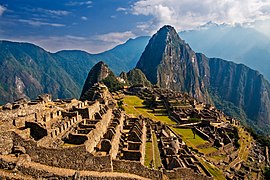
Back Machu Picchu Afrikaans Machu Picchu ALS ማቹ ፒቹ Amharic ماتشو بيتشو Arabic ماتشو بيتشو ARZ Machu Picchu AST Machu Pikchu Aymara Maçu Piçu Azerbaijani Macchu Picchu BAN Machu Picchu BCL
 Machu Picchu in 2007 | |
| Location | Cusco Region, Peru |
|---|---|
| Coordinates | 13°09′48″S 72°32′44″W / 13.16333°S 72.54556°W |
| Altitude | 2,430 m (7,972 ft) |
| History | |
| Founded | c. 1450 |
| Abandoned | 1572[1] |
| Cultures | Inca civilization |
| Site notes | |
| Discovered | Agustín Lizárraga (1902) Hiram Bingham (1911) |
| Archaeologists | Hiram Bingham |
| Website | https://www.machupicchu.gob.pe/?lang=en |
| Official name | Historic Sanctuary of Machu Picchu |
| Location | Latin America and the Caribbean |
| Criteria | Mixed: i, iii, vii, ix |
| Reference | 274 |
| Inscription | 1983 (7th Session) |
| Area | 38,160.87 ha |
Machu Picchu is a 15th-century Inca citadel located in the Eastern Cordillera of southern Peru on a 2,430-meter (7,970 ft) mountain ridge.[2][3] Often referred to as the "Lost City of the Incas", it is the most familiar icon of the Inca Empire. It is located in the Machupicchu District within Urubamba Province[4] above the Sacred Valley, which is 80 kilometers (50 mi) northwest of Cusco. The Urubamba River flows past it, cutting through the Cordillera and creating a canyon with a tropical mountain climate.[5] In reference to the site's name, for most English or Spanish speakers, the first 'c' in Picchu is silent. In English, the name is pronounced /ˌmɑːtʃuː ˈpiːtʃuː/ MAH-choo PEE-choo[6][7] or /ˌmætʃuː ˈpiːktʃuː/ MATCH-oo PEAK-choo,[7][8] in Spanish as [ˈmatʃu ˈpitʃu] or [ˈmatʃu ˈpiɣtʃu],[9] and in Quechua (Machu Pikchu)[10] as [ˈmatʃʊ ˈpɪktʃʊ].
The Inca civilization had no written language and following the first encounter by the Spanish soldier Baltasar Ocampo, no Europeans are recorded to have visited the site from the late 16th century until the 19th century. As far as historical knowledge extends, there are no existing written records detailing the site during its period of active use. The names of the buildings, their supposed uses, and their inhabitants, are the product of modern archaeologists based on physical evidence, including tombs at the site. Machu Picchu was built in the classical Inca style, with polished dry-stone walls. Its three primary structures are the Temple of the Sun, the Temple of the Three Windows, and the Intihuatana. Most of the outlying buildings have been reconstructed in order to give visitors a better idea of how they originally appeared.[11] By 1976, 30 percent of Machu Picchu had been restored[11] and restoration continues.[12] Most recent archaeologists believe that Machu Picchu was constructed as an estate for the Inca emperor Pachacuti (1438–1472). The Incas built the estate around 1450 but abandoned it a century later, at the time of the Spanish conquest. According to the new AMS radiocarbon dating, it was occupied from c. 1420–1532.[13] Historical research published in 2022 claims that the site was probably called Huayna Picchu by the Inca people themselves, as it exists on the smaller peak of the same name.[14][15]
Machu Picchu was declared a Peruvian Historic Sanctuary in 1982 and a UNESCO World Heritage Site in 1983.[3] In 2007, Machu Picchu was voted one of the New Seven Wonders of the World in a worldwide internet poll.[16]
- ^ Jarus, Owen (31 August 2012). "Machu Picchu: Facts & History - Abandonment of Machu Picchu". Live Science. Retrieved 16 December 2019.
- ^ "Historic Sanctuary of Machu Picchu". UNESCO World Heritage Centre.
- ^ a b UNESCO World Heritage Centre.
- ^ escale.minedu.gob.pe – UGEL map of the Urubamba Province (Cusco Region)
- ^ CarlottoCardenasFidel 2009.
- ^ "Machu Picchu". Lexico UK English Dictionary. Oxford University Press. Archived from the original on 28 January 2021.
- ^ a b "Machu Picchu". Merriam-Webster.com Dictionary.
- ^ "How to say: Machu Picchu". 8 September 2006.
- ^ "Machupicchu o Machu Picchu? ¿Cómo se escribe esta maravilla del mundo?". 5 April 2010.
- ^ Nonato Rufino Chuquimamani Valer, Carmen Gladis Alosilla Morales, Victoria Choque Valer: Qullaw Qichwapa Simi Qullqan. Lima, 2014 p. 70
- ^ Davey 2001.
- ^ Burger, R. L.; Salazar, L. C.; Nesbitt, J.; Washburn, E.; Fehren-Schmitz, L. (August 2021). "New AMS dates for Machu Picchu: results and implications". Antiquity. 2021 (383): 1265–1279. doi:10.15184/aqy.2021.99. S2CID 238220619.
- ^ Cite error: The named reference
:0was invoked but never defined (see the help page). - ^ NPR: "We've been calling Machu Picchu by the wrong name" 27 March 2022
- ^ "Creating Global Memory". New7Wonders of the World. Retrieved 25 October 2017.
© MMXXIII Rich X Search. We shall prevail. All rights reserved. Rich X Search
